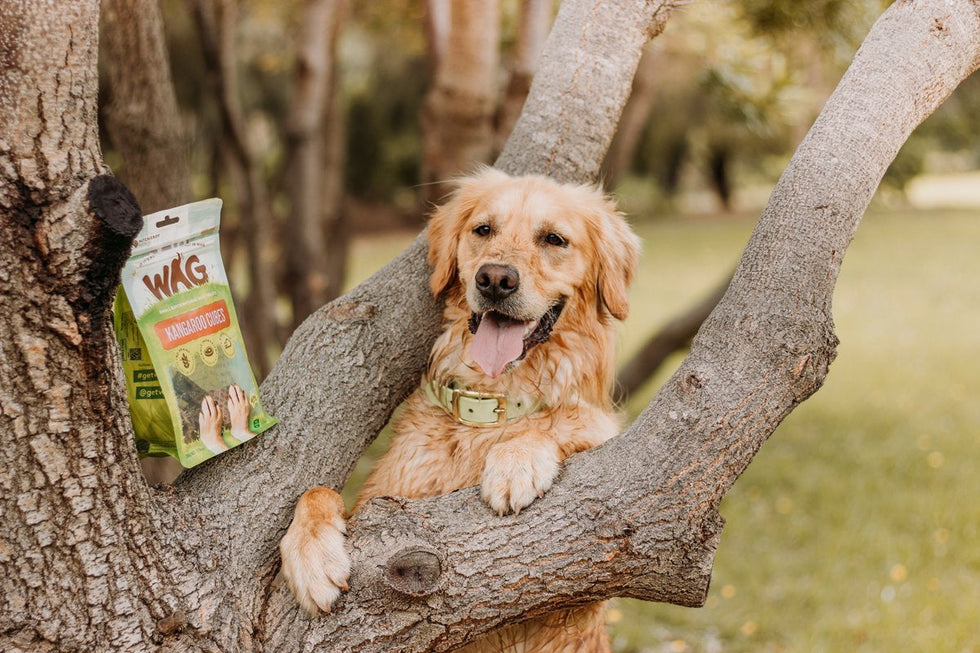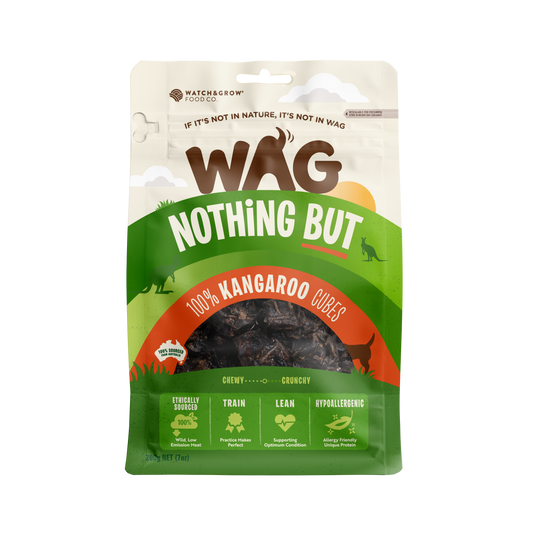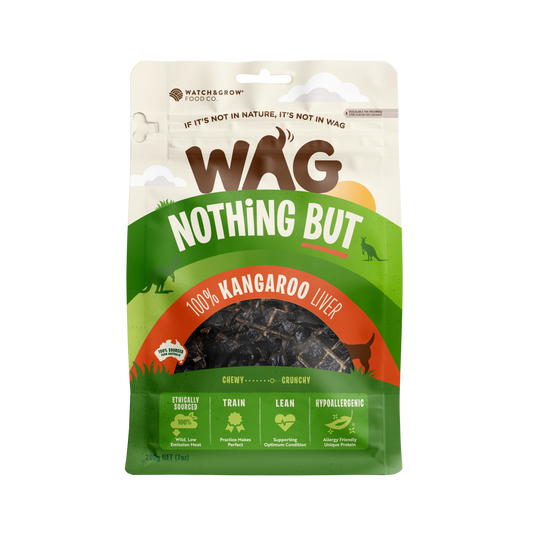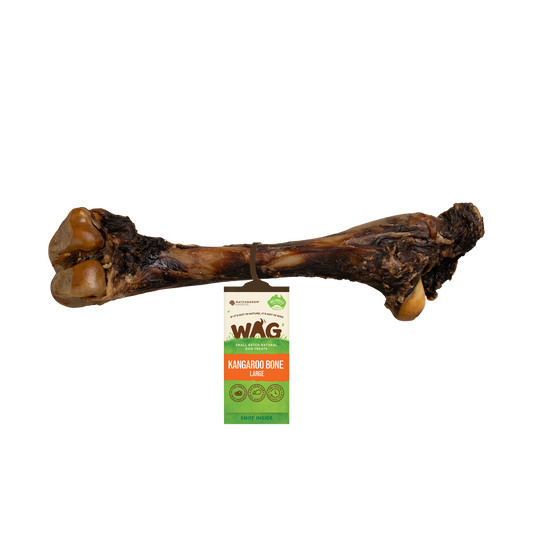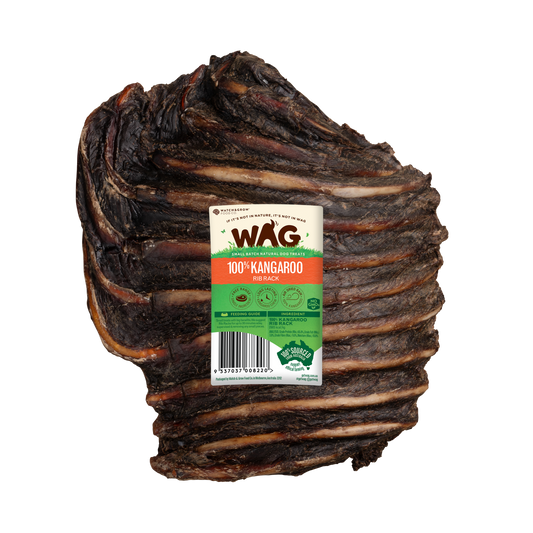If you feed your dog kangaroo food or treats, you should know you’re doing a good thing. But depending on where you come from, the confidence in that statement changes.
Traditionally kangaroo has not been a popular choice in protein across the globe. Mainstream meat-eaters have rejected the consumption of kangaroo. States like California have banned kangaroo from sale and importation, and sales of kangaroo incur a heavy penalty.
But for Aussies, chowing down on kangaroo meat isn’t all too strange. You can find kangaroo in most Australian supermarkets and butchers, and no one bats an eye. If you haven’t personally eaten it, you likely know someone who has.
But there is still some debate between Australians on how acceptable or ethical it is to feast on our country’s national emblem. Is it right to eat kangaroo? And is it okay to feed kangaroo meat for your dogs?
Here’s why you should feed your dog kangaroo.
Why should you feed your dog kangaroo?
As ethical consumption champions and advocates for making sustainable choices, we are confident in kangaroo meat. Not only is it eco-friendly, but choosing kangaroo meat is a sustainable and healthy choice when it comes to your dog’s health. We want to shine a light on the reasons why kangaroo is right for your dog.
In general, feeding your dog kangaroo is one of the most environmentally conscious choices you can make as a dog owner. Kangaroos aren’t farmed, and their populations are monitored and controlled. And they’re a nutritious, lean and hypoallergenic meat.
Kangaroo is a sustainable choice when it comes to meat
It’s undeniable that aspects of the meat industry are not as sustainable as they could (and should) be. The practice of breeding animals for the production of their products, known as animal or livestock agriculture, is not very eco-friendly.
Modern animal agricultural processes are intensive and drain enormous amounts of environmental resources. These processes are associated with producing pollution through fossil fuel usage, water and land consumption, and animal methane. All contribute to a detrimental environmental footprint.
According to The Conversation, livestock farming contributes 18% of human produced greenhouse gas emissions worldwide. Animal agriculture leaves one of the largest water footprints on the planet. Beef is the primary reason for deforestation in the Amazon, with some figures speculating up to 70% of the ancient jungle cut down for pasture.
How is kangaroo any different?
In comparison, the kangaroo farming industry appears angelic. All kangaroos are completely wild – they’re not farmed. They roam the vast Australian lands at their own discretion. And our wildlife and land don’t need to be deforested to house and breed them.
Some groups express concern at endangering kangaroo populations through consumption. But the evidence says otherwise. Kangaroos exist in staggering numbers. Approximately 50 million live throughout the Aussie outback – that’s double the human population in Australia! With no traditional predators remaining, kangaroo populations have boomed. They breed without restriction and survive on the scarcest resources.
Australia does not farm its kangaroos
The kangaroo industry in Australia is sustainable and humane. It’s said to be the most sustainable meat trade in the world. The kangaroo industry works in close partnership with the Australian government and independent experts to monitor the kangaroo population.
Quotas are set for commercial harvesting and these are set with reference to the aerial population survey. It’s never more than 20% of the total population.
Conservation and environmental protection communities throughout Australia support the use of strict and regulated quotas. Those quotas are based on scientific survey methods, and get conducted to keep an eye on kangaroo populations.
Key facts to keep in mind:
- Only 4 out of 48 species can be commercially harvested. Around 3% of Australia’s 50 million kangaroos are used for meat production each year.
- Kangaroo populations rise and fall with seasonal conditions. During extended droughts, their numbers decrease again.
- Studies have shown that this method has no long-term negative impact on the environment. This result comes from more than 60 years of commercial harvesting.
- Population surveys are conducted regularly. A maximum quota of 15–20% of the kangaroo population can be harvested in any year.
So you can rest assured that the treats you’re feeding your dog haven’t come from bad welfare practices!
They’re environmentally friendly
In recent years environmentalists have pointed the finger at the animal industry and their production of greenhouse gases. Experts agree that livestock is responsible for 18% of all greenhouse gas emissions with beef representing 65% of these gasses, followed by pig meat, and lastly chickens.
While kangaroos do produce methane gases equivalent to that of horses, the amount is still significantly less than cows.
Kangaroos contribute less to greenhouse gases due to their unique process of digestion. Kangaroos don’t just digest their food – they also ferment it! This means that food travels throughout the stomach and digestive system quicker, allowing less time for microbes to break down the food and produce methane.
It’s not just emissions that make kangaroo the right choice. Scientists suggest that harvesting kangaroo food and fibres is “eminently wise and sustainable”, especially given they make up twice the human population. Kangaroos often compete with beef or sheep for scant resources available in the unforgiving Aussie outback.
Kangaroo is seriously healthy
Meat is essential for the health and longevity of our dogs. Kangaroo boasts an impressive nutrient list, including a variety of benefits for chowing down on the unique protein.
Kangaroo is a particularly lean meat, containing less than 2% fat. This makes it one of the healthiest red meat options. It’s suitable for dogs of all diet types, particularly those that are sensitive, like sufferers of pancreatitis. It is also considered to be jam-packed full of Iron, a mineral essential for supporting immune function and boosting metabolism. It’s rich in B vitamins, Omega 3 and Zinc, giving your dog that a nutrient boost in each bite.

What if my dog is allergic to kangaroo?
Roo is often described as hypoallergenic, meaning it’s relatively unlikely to trigger an allergic reaction. While there are dogs that are allergic to kangaroo meat, it’s proven to be less likely to trigger an allergic episode, and is often recommended by vets for doggos with dietary restrictions.
Allergies develop when a dog’s immune system incorrectly identifies an ingredient as harmful and develops antibodies to fight it. These antibodies wage war on the identified ingredient, and by extension, your dog. Allergies generate a range of symptoms, such as inflammation, scratching, and discomfort. And each time your dog’s immune system encounters the allergy-inducing ingredient, the immune response grows stronger… and more dangerous.
Roo meat is considered a rare and novel protein. It’s generally something that most doggo’s won’t encounter in their daily meal. Because of this, dogs are unlikely to develop an allergy to kangaroo in the same way they would beef or chicken.
So what do I feed my dog when they are allergic to kangaroo?
We have encountered a dog or two who were allergic. You can read more about how Sarah discovered her dog’s kangaroo allergy, and how you can work through an allergy diagnosis. Nowadays, Sarah makes it her mission to indulge Chloe with food and treats that are healthy, delicious and everything but kangaroo.
For the unlucky few who have developed an allergy to kangaroo, there are some tip-top alternatives. Venison and goat are fine substitutes if you’re seeking out novel and low-allergenic proteins. Fish is another gold-standard option for sensitive stomachs. And it’s a lot more accessible, especially in Australia.
Will you be feeding your dog kangaroo?
It’s good to feel good about what you’re feeding your dog. Whether you feed kangaroo as their main meal or in the form of bones or treats, know your dog is benefitting from the inclusion of roo!
Shop the Recipe
WAG Team
Up Next
Is feeding your dog kangaroo bad for the environment?
